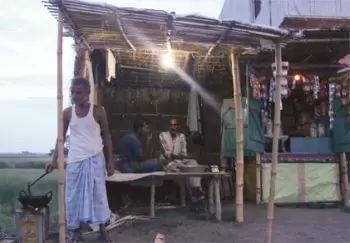Off-grid bio-mass plants lights up life of villagers

23-November-2012
Vol 3 | Issue 47
It is 10 pm. Too late in the night by village standards. But the four benches around Mote Singh’s tea stall are occupied. People are chatting while sipping tea.
More than a year ago, the stall in Sahebganj village of Bihar’s Muzaffarpur district used to be empty by 6 pm. Singh’s fortune has been illuminated by a 15 Watt CFL. The village has an electricity grid but supply is negligible.
 |
|
People in Sahebganj used to spend Rs 250 on kerosene-generated electricity in a month. Now they pay Rs 50 a month for a 15 Watt connection for six hours a day (Photo: Ankur Paliwal)
|
“Till mid-2011, I used to close my stall by sunset. Managing with kerosene lamp was expensive,” says Singh, the sole earner of a family of five, who used kerosene to light his house. Kerosene costs him Rs 250 a month.
In June last year, life changed for many in Sahebganj as they started getting electricity every day from 6 pm to 12 pm. The residents thank Husk Power Systems (HPS), a company in Patna, that has installed two off-grid biomass gasification plants with 32 KW capacity each in the village.
These plants convert solid biomass into gas which is then used to generate electricity. Each plant uses 300 kg of rice husk every day to power 40 per cent of the households in Sahebganj.
HPS monthly charges Rs 50 per household for a 15 Watt connection for six hours a day. Money is collected in advance to avoid defaulters. Plant operators say village residents essentially require power for six hours. HPS has set up 80 such plants of varying capacities across Bihar.
With big grid-connected biomass plants failing across the country, the Ministry of New and Renewable Energy (MNRE) is pushing for small off-grid plants. “They need less biomass and villages prefer selling biomass to the developers because they get electricity. Transmission and distribution losses also reduce,” says D K Khare, director of biomass gasification, MNRE.
Although most experts hail the HPS model, there are a few critics. Sunil Dhingra, senior fellow at Delhi NGO The Energy and Resource Institute, says developers are charging unreasonably due to unregulated tariff for off-grid energy solutions.
HPS charges Rs 18.51 per unit, while an average consumer pays Rs 4 per unit for conventional energy.
“States should decide on a reasonable tariff and some of it should be subsidised,” suggests Dhingra. For instance, if the government decides Rs 10 per unit as tariff and the cost of generation is Rs 13, then the balance (Rs 3) should be subsidised, he says. Ratnesh Yadav, co-founder of HPS, clarifies that if a developer charges an exorbitant amount the public will not pay.
“We operate in a market where the moment we charge irrationally someone will replace us,” he adds.
Residents of Sahebganj are happy with the tariff they are paying. “It is cheaper than kerosene and diesel,” says Sohan Ram, who has taken a 30 Watt connection. For diesel operated energy, a 15 Watt connection costs Rs 100 for four hours.
Greenpeace India, which advocates the HPS model, proposes an alternative for tariff regulation: the government should set up small distribution networks (mini-grids) in villages.
“It can enter into a power purchase agreement with the developer to buy power at a preferential tariff from the developer and collect the standard tariff amount from the consumer,” says Manish Ram, renewable energy analyst, Greenpeace India.
Suppose, the government is buying power at Rs 10 per unit from the developer, it can charge Rs 4 per unit from the consumer and subsidise the rest over a period of time until they eventually reach grid parity (the point at which the cost of renewable energy equals the cost of utility power from conventional sources). Later, the mini grids can be interconnected with the main grid.
By arrangement with Down to Earth
















